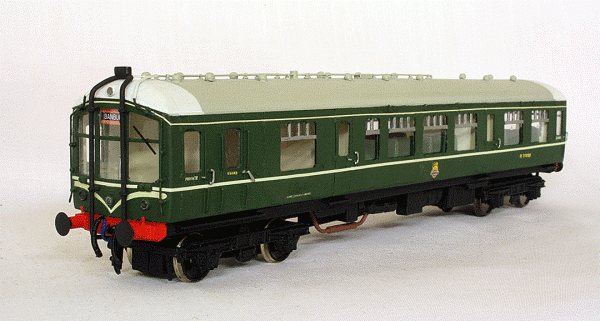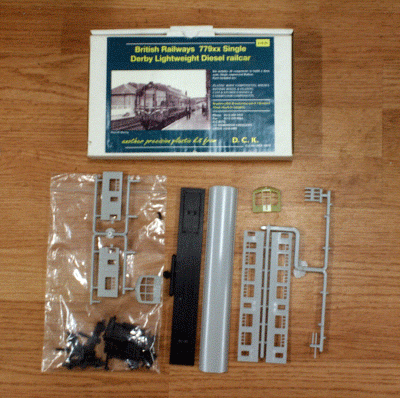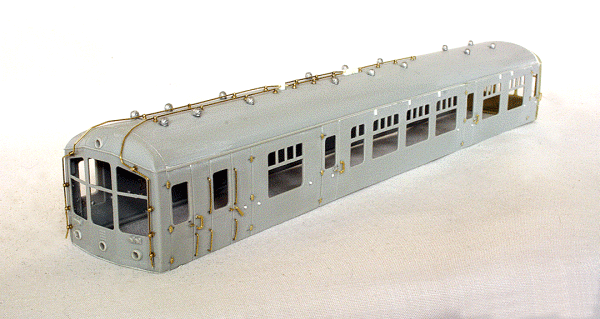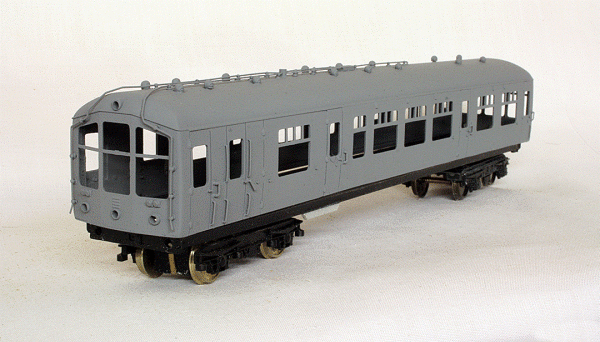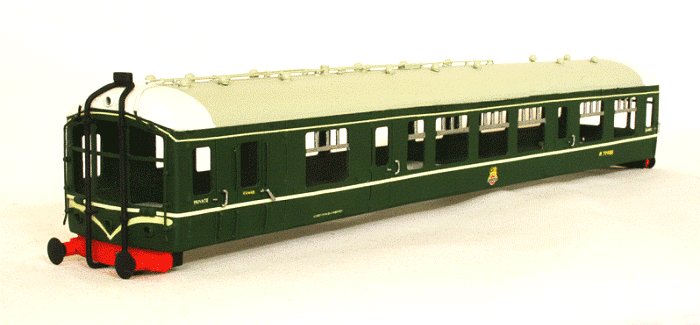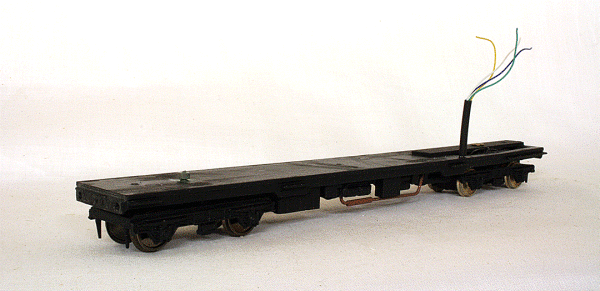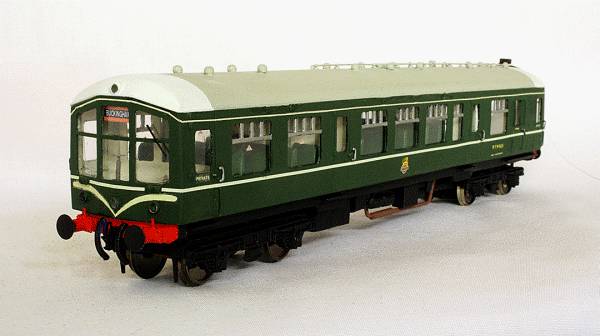Steve Johnson Modelmaker
|
|
Derby Lightweight Single Car
Derby Lightweight Single Car, Brake End The Derby Lightweight DMU's were the first major production DMU type built by British Railways. They were built at BR's Derby Works between 1954 and 1955. They were called 'Lightweights' because they used an aluminium alloy (Kynal) in the body construction to save weight. This was to cause corrosion problems in later life. They were originally produced as 2 and 4 car units. Two single car units were converted from a two DMBS's before delivery. This is the subject of this page. These two units were for the Banbury (Merton Street)-Buckingham experiment. With the eventual closure of this line on 2nd January 1961, the two vehicles operated the Buckingham-Bletchley service. With the closure of the Buckingham-Verney Junction line in September 1964, the units worked the Oxford-Bletchley service. M79901 was withdrawn in 1966 and M79900 was transferred to York as a route learning vehicle in September 1967. It was converted to 'Test Car Iris' in October 1967 and remained in Departmental Service until being withdrawn in 2000. M79900 was fortunately preserved and has been extensively restored. It is currently operating on the Ecclesbourne Valley Railway. Two 'double ended' single cars were converted from two standard DMBS's M79182 and M79183 originally destined for the Manchester Part 1 scheme. They were numbered M79900 and M79901. The cars were not identical, M79900 originally had a smaller guards compartment than M79901. Following complaints of the lack of luggage space, a seating bay adjacent to the guards compartment was removed and the bulkhead moved further back. This reduced the seating from 61 to 52. The full passenger window remained distinguishing it from M79901 which had a much smaller window in this position. I always advise working from photographs of the actual unit in the condition you want. It should be noted that M79900 did go through several body and livery versions. As preserved, it is close to, but not in 'original as built' condition.
Some of the parts supplied My take on these units is the DC Kits model. Although DC Kits had advertised the model as a M799xx, the body mouldings supplied will only make M79900. As mentioned, DC Kits had offered a kit of the single car Derby Lightweight for a number of years. Unfortunately I didn't buy one at the time and was later left with the problem of how to make one. As luck would have it, whilst trawling through eBay for something else, I came across a complete unbuilt kit for sale. I duly put a bid in and managed to 'win' it. Obviously it cost me more that if I had bought the kit when it was available. That will teach me!
Body assembled with fittings added The kit is designed to run on either a Tenshodo SPUD or Black Beetle motor bogie. Sadly the Black Beetle doesn't seem to be available any more and although a Tenshodo SPUD would manage a single car easily, they are not the smoothest of runners. As it happens, I had another somewhat long term build going on, a DC Kits Class 120 Swindon Cross Country 3 car unit. This does have a Black Beetle as power. So my thought here was to use the Class 120's Black Beetle under the Derby Lightweight Single car and buy another bogie for the Class 120 which would easily manage a 3 car unit.
Body primed sitting on chassis The DC Kits bodies can lack a bit of detail relief, so as can be seen, I have added separate had rails, door handles, door grab rails, bump stops and the water pipes. The other major item missing was the distinctive exhaust pipe! Although exhaust pipes were included in the kit, they were not the ones for this unit. My solution was to bend some solid brass rod to shape. this did take a few attempts to get right, but is worth it, I think, in this instance. The 'crown' of the pipes was fashioned from some brass bar I had and soldered to the pipes. The exhausts also stand off the body a bit, so to create this I made some loops out of brass wire with 'tails' and soldered them to the pipes in the correct places. Holes wee drilled into the window pillars to accept the 'tails' and secured with glue. The lights have also been drilled out for the lighthouse LED's to be fitted later. With the body finished, it was time to spray it with the top coats. I used Halfords Ford Laurel Green and Halfords Ford Dove Grey for the roof. These are quite good matches. The cab roof sections are painted white. Fox Transfers were used for the numbers and lining. The 'Speed Whiskers' were Modelmaster. The body was then sprayed with Phoenix Precision Satin Varnish.
M79900 Body painted, decorated and varnished With the body exterior finished, the next job is to fit and paint the interior, then fit the glazing. Seating is not supplied in the kit and I had to source this separately. Fortunately, DC Kits still had some! The seats appear to be a mid green moquette, so I chose the nearest shade I could find. The bulkheads were cut from plasticard and glued to the inside of the body. The ceiling appears to have been an off white with the main interior a sort of light cream colour. Glazing was simply cut from 10 thou. clear acetate sheet and secured in place by Glue'n'Glaze. The front compartment furthest from the brake end was the No Smoking area. As such, Fox Transfers triangular No Smoking signs were fitted to the insides of the window. I made up the destination blinds on my computer and printed them onto photographic paper. These were then cut to shape and fitted behind the top centre panes with a dab of Glue'n'Glaze. I prefer to use this product as it is PVA based and doesn't 'fog' the acetate as Cyanocryalate can do. It also dries clear.
Chassis The chassis now needed attention. The underfloor equipment (engines, radiators, batteries, heaters etc.) was now fitted. Some parts were provided in the kit and some other parts I made. As supplied, some of the equipment is in the form of brass etches. This is fine, but look a little flat, so were bulked out to add a bit of depth with plasticard. Exhaust pipes and silencers were fabricated from brass tube and rod respectively. When complete, the chassis was painted black with the exhausts picked out in bauxite. The brake pipes and coupling ended up presenting a problem! I had intended to use the wire wound Romford vacuum pipes, but they are no longer made. A trawl through eBay found some for sale, which I duly bought. I wanted to use this type as I will have to alter and bend the wire a bit to get them coming from under the buffer beam. My choice of coupling for years has been the Exactoscale couplings. I did have a stock of them, but this has been depleted over the years and yes, these are no longer made either! I did have some Romford screw link couplings in stock, but couldn't believe how big they were. I needed an alternative. Fortunately, Hornby make some fine screw couplings as an accessory. So a pack of R7200 was ordered. There are four in a pack, so the other pair will find their way onto the Swindon Class 120 Cross Country that is also in the 'Works'. The model was intended to be DCC fitted, but deciding where to put the decoder was another matter. After some consideration, I used a Digitrax DN136D fixed to the underside of the chassis. It is pretty much hidden by the underfloor equipment and provides a running chassis. Four wires however, still have to make their way from the chassis to the body for the lighting functions. These wires come through a hole in the chassis positioned so that they will run up the corner of the brake compartment. Once painted, they will not be too noticeable. The lighting wires in the car body terminate on a piece of PCB board glued to the ceiling. When it came to fitting the body to the chassis, the four lighting wires (A End marker lights, B End marker lights, Car Interior lights and common) had to be soldered to the PCB Board. Not a lot of slack here!
Derby Lightweight Single Car Having completed the model, I discovered I had fitted the wrong headcode indication! When introduced, these units ran as Class 2 passenger trains, so should have just the single top light illuminated, with a red tail lamp the other end. I had just automatically illuminated the two lower outer lamps, which is a Class 1 Express Passenger train! Doh!
Silver Fox Models also offer the single car version as Test Coach Iris or the 2 car version as Test Unit Gemini and Craftsman Models produced a conversion kit based on the Lima Class 117. DC Kits offered a kit of this class in various versions, which is the one built. MTK also offered a kit of this class as a 2 car unit and single car unit. Anbrico produced a kit of this class some years ago.
|
